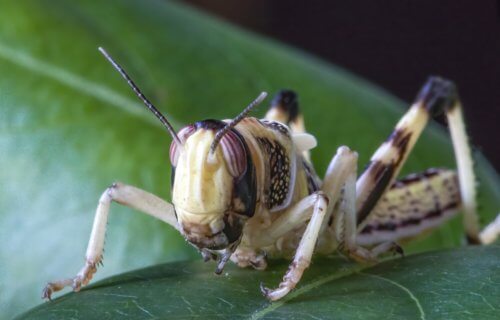EAST LANSING, Mich. — They may be one of the seven plagues, but groundbreaking new research from a team at Michigan State University finds locusts may be key to early cancer detection. MSU scientists have found that locusts can actually “smell” the difference between cancer cells and healthy cells in humans.
That’s not all: Locusts can even differentiate between various cancer cell lines. Study authors believe their findings, which have not been peer-reviewed yet, are laying the early groundwork for devices that use insect sensory neurons to detect cancer early via nothing but a patient’s breath.
While many people are used to falling back on technology that enhances our natural senses, such as a telescope or microscope, researchers add that there’s no replacing the nose. For example, humans still rely on dogs to sniff out drugs, bombs, and in recent scenarios, even health issues like low blood sugar or COVID-19.
“Noses are still state of the art,” says Debajit Saha, an assistant professor of biomedical engineering at MSU, in a university release. “There’s really nothing like them when it comes to gas sensing.”
Scientists have tried for years to create a technology that can mimic the sense of smell, but nothing as of yet has proven capable of replicating both the sensitivity and specificity of old-fashioned biological olfaction.
“People have been working on ‘electronic noses’ for more than 15 years, but they’re still not close to achieving what biology can do seamlessly,” Prof. Saha adds.
Circling back to cancer, early detection is of the utmost importance. When doctors catch cancer during stage one, patients still have an 80 to 90 percent chance of survival. Cancer detected at stage four, meanwhile, results in a 10 to 20 percent chance of survival.
Cancer cells and healthy cells operate quite differently, creating different chemical compounds as they work and grow. If these cancer-related chemicals reach an individual’s lungs or airways, the compounds are detectable in a person’s breath.
“Theoretically, you could breathe into a device, and it would be able to detect and differentiate multiple cancer types and even which stage the disease is in. However, such a device isn’t yet close to being used in a clinical setting,” Prof. Saha explains.
So, the research team at MSU decided to try a new approach. Instead of continually attempting to create something that mimics biology, they opted to let nature do the work for them. By beginning with the solutions already perfected by biology and eons of evolution, researchers say they are essentially “hacking” the insect brain to use it for disease diagnosis.
“This is a new frontier that’s almost unexplored,” Prof. Saha notes.
Why locusts?
Prof. Saha and his team explain locusts have served the scientific community as model organisms, like fruit flies, for a number of decades. Modern science holds a comprehensive understanding of their olfactory sensors and corresponding neural circuits. Moreover, in comparison to fruit flies, locusts are larger and more rugged.
All of these factors, researchers say, made locusts the ideal study subjects. On a more practical level, it was easy for the team to attach electrodes to the locusts’ brains. Next, researchers recorded insects’ responses to gas samples produced by healthy cells and cancer cells. They then used those signals to create chemical profiles of the different cells.
In 2020, while at Washington University in St. Louis, Prof. Saha led a similar research project. At that time, he was working on creating bomb-detecting technology with the help of locusts. That earlier work factored into an MSU search committee recruiting Saha, explains Christopher Contag, the director of MSU’s Quantitative Health Science and Engineering.
“I told him, ‘When you come here, we’ll detect cancer. I’m sure your locusts can do it,’” says Contag, the inaugural James and Kathleen Cornelius Chair, who is also a professor in the Department of Biomedical Engineering and in the Department of Microbiology and Molecular Genetics.
One of Prof. Contag’s main areas of focus is better understanding why cells produced from mouth cancers display distinct appearances when placed under a microscope. Earlier work by his lab has found different metabolites in different cell lines, partially explaining some of those optical differences. Moreover, some of those metabolites turned out to be volatile, meaning they could become airborne and “sniffed out.”
“The cells looked very different metabolically, and they looked different optically,” Prof. Contag comments. “We thought it made a lot of sense to look at them from a volatiles perspective.”
The newly developed locust sensors by Prof. Saha’s team provided the perfect way to test that. The two MSU contingents collaborated to determine just how accurately locusts can differentiate healthy cells from cancer cells via three distinct oral cancer cell lines.
“We expected that the cancer cells would appear different than the normal cells,” Prof. Contag explains. “But when the bugs could distinguish three different cancers from each other, that was amazing.”
While these results focused solely on oral cancers, study authors are confident their approach would work just as well with any cancer that introduces volatile metabolites into the breath – which likely encompasses most cancers. Right now, researchers are putting together a collaboration with Steven Chang, director of the Henry Ford Head and Neck Cancer program, to test the detection system with human breath.
Why stop at locusts? Researchers add that they’re also keen on investigating the chemical sensing power of honeybees. They’ve already observed promising preliminary results while using honeybee brains to detect volatile lung cancer biomarkers.
“Early detection is so important, and we should use every possible tool to get there, whether it’s engineered or provided to us by millions of years of natural selection,” Prof. Contag concludes. “If we’re successful, cancer will be a treatable disease.”
The study is published in the pre-print server BioRxiv.

